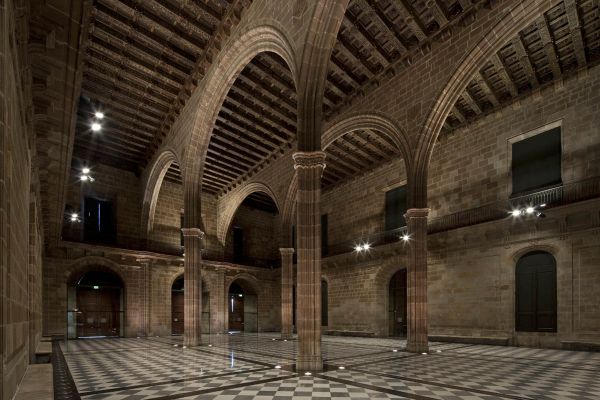Most of the works of art we admire are produced by artists who have studied in fine art schools, which we imagine as being full of easels, blanc canvases, paint brushes, lathes, clay, chisels, blocks of stone waiting to be made into sculptures and plates ready to be etched. In Barcelona there are art schools that hold important collections, so let's find out about them.
LA LLOTJA DE MAR - REIAL ACADÈMIA CATALANA DE BELLES ARTS DE SANT JORDIThe first stop is the magnificent building of Barcelona's Llotja de Mar. The upper floor houses the
Reial Acadèmia Catalana de Belles Arts de Sant Jordi (1), established towards the end of the 19th century to encourage the teaching of fine art through the Llotja school. It no longer has this educational purpose and is now focused on raising awareness about its artistic, bibliographic and archival collections.
Its artistic collection consists of more than 700 paintings, 250 sculptures and numerous drawings and prints by artists from the 16th to 20th centuries, from Annibale Carracci and Joan Ribalta to Modest Cuixart and Josep Maria Subirachs. Worthy of special note are the collections of drawings by Pau Milà i Fontanals and Lluís Rigalt. Furthermore, the Museu de l’Acadèmia is a guiding light, especially with regard to Catalan art of the 18th and 19th centuries, with paintings by Marià Fortuny and Ramon Martí Alsina, amongst others.
Cases Singulars organises guided tours to visit the rooms in this building, from the vestibule to the boardroom, all of which are imbued with an academic ambience.
CENTRE ARTÍSTIC DE SANT LLUCNot too far away is the
Cercle Artístic de Sant Lluc (2), an artists' association founded in 1893 at the height of
Modernisme. It is located in the Palau Mercaders and today it still keeps the exchange of ideas and artistic practice alive with activities devoted to drawing, sculpture, etching, photography and video. There is also a hall where temporary exhibitions are held.
The Cercle Artístic de Sant Lluc forms part of the
European Modernisme Route because of the importance of the meetings that were held here attended by Antoni Gaudí, the brothers Joan and Josep Llimona, Alexandre de Riquer, Enric Sagnier, Eusebi Arnau and Gaspar Homar, amongst others.
The institution's heritage, diminished on account of changes of address and the Spanish Civil war, today includes iconic works by its founders, such as the standard, designed by Alexandre de Riquer, a veritable jewel of embroidery, his poster for the 5th collective members exhibition and the large oil painting by Joan Llimona entitled,
Dona mullant-se el peu. Furthermore, there is a very fine collection of
Modernista, or
Art Nouveau magazines from around the world, such as
Le Japon artistique,
Jugend,
The Studio,
Hispania and
Pèl&Ploma.
ESCOLA MASSANA. CENTRE D'ART I DISSENY
Without leaving the historic centre of Barcelona you will find the
Escola Massana, Centre d’Art i Disseny (3) in the Plaça de la Gardunya. Since it was founded in 1929 this school has reverberated with the sounds of commotion caused by the students who have come and gone in search of their Art and Design degrees, their Postgraduate Contemporary Applied Arts degrees and other similar academic qualifications. Art is in constant flux here. One way to get to know the Escola Massana better is to take part in one of the events or exhibitions it holds that are open to the public. The Espai Busquets, for example, runs a constant programme with exhibitions of works by external artists and designers that alternate with the best final year projects by the school's students.
FACULTAT DE BELLES ARTS DE LA UNIVERSITAT DE BARCELONA The last visit is to Barcelona University’s
Faculty of Fine Arts (4) located in the university area of the Avinguda Diagonal. The faculty has its origins in the Escola Gratuïta de Disseny (Free Design School) founded in 1775 in Barcelona with the support of the Board of Trade. That might, at first, seem a little strange but drawing needed to be encouraged in order to satisfy the demands of the industries of the day. In 1849 painting, sculpture and architecture were added and, almost a century later, the department of Fine Arts separated from the applied subjects to become the Escola de Belles Arts de Sant Jordi (yes the one in the Llotja de Mar), which in 1978 became today's Faculty of Fine Arts.
Over the course of years many renowned artists passed through this school such as Damià Campeny, Marià Fortuny, Pau Gargallo, Josep Llimona, Joan Miró, Isidre Nonell, Pablo Ruiz Picasso and Modest Urgell. The past and present creative fervour of this school can be best appreciated with a visit to the faculty's exhibition hall, which is open to the public and holds exhibitions of creative works by students, teachers and former students, as well as works from private collections.
*An excursion proposed in collaboration with the magazine Descobrir.

